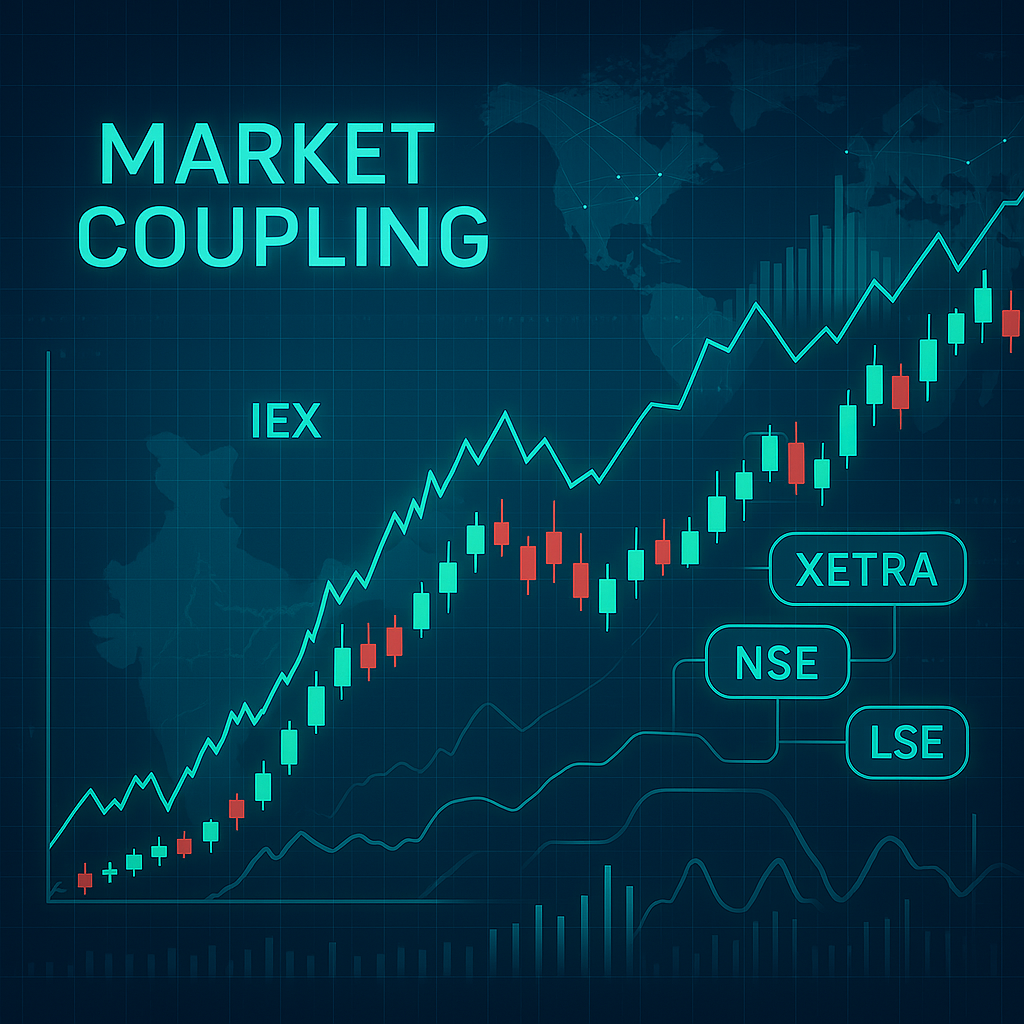
Market Coupling Stocks: How India’s IEX Faces a New Regulatory Reality

The Central Electricity Regulatory Commission’s (CERC) approval of market coupling for power exchanges has triggered a steep 30% drop in IEX stock. Discover what this means for investors, competition, and India’s energy equity landscape.
Table of Contents
Introduction: A Historic Shift in India’s Power Trading Landscape
The Central Electricity Regulatory Commission (CERC) implemented a transformative decision on July 24, 2025, that has redefined the structure of India’s electricity trading sector. The regulatory body approved market coupling for the Day-Ahead Market (DAM), introducing a unified pricing mechanism across multiple power exchanges.
This regulatory intervention has disrupted the existing market structure where Indian Energy Exchange (IEX) maintained overwhelming dominance. The announcement triggered significant market reactions, with IEX witnessing its largest single-day decline since listing. Market participants are now reassessing competitive dynamics and evaluating how this structural change will impact trading patterns, pricing mechanisms, and profitability across the sector.
The implementation represents a shift toward international best practices observed in developed electricity markets. Understanding the technical framework, market implications, and financial consequences of this decision is essential for investors, traders, and policy analysts monitoring India’s energy sector evolution.
Understanding Market Coupling: Technical Framework and Implementation
Core Mechanism of Market Coupling
Market coupling functions as a centralized clearing system that processes bidding data from multiple electricity exchanges simultaneously. The system employs advanced algorithms to determine uniform pricing across all participating platforms based on aggregate supply and demand conditions.
The clearing mechanism operates through a designated price operator role that rotates among participating exchanges. This rotation ensures that no single platform maintains permanent control over price determination. The algorithm considers transmission constraints, regional demand patterns, and generation capacity availability when calculating market-clearing prices.
The technical infrastructure requires seamless data integration between exchanges, real-time processing capabilities, and standardized communication protocols. Implementation involves coordination between regulatory authorities, exchange operators, and grid management entities to ensure operational reliability.
Operational Benefits and Efficiency Gains
The unified clearing system eliminates price discrepancies that previously existed across different trading platforms. Market participants can now access consistent pricing information regardless of which exchange they use for transactions. This standardization reduces complexity for traders managing positions across multiple venues.
The system enhances market efficiency by directing electricity flows toward regions where demand valuation is highest. Grid operators benefit from improved visibility into aggregate market conditions, enabling better resource allocation and congestion management. The reduction in arbitrage opportunities means electricity resources are deployed more optimally across the national grid.
Transparency improves significantly under market coupling, as all participants receive simultaneous access to market-clearing prices and trading volumes. Information advantages that dominant platforms previously enjoyed through superior market positioning are substantially reduced. This level playing field encourages broader participation from smaller traders and new market entrants.
International Implementation Experience
European electricity markets pioneered market coupling implementation starting in 2006, eventually integrating more than 20 national grids into a coordinated trading system. Research indicates that price convergence improved substantially, with spreads between previously disconnected regions declining by significant margins over time.
North American markets operate similar centralized dispatch systems through Regional Transmission Organizations and Independent System Operators. These frameworks have demonstrated improved reliability metrics and cost efficiency compared to fragmented trading arrangements. The successful operation of these international models provided regulatory confidence for India’s implementation.
Australia’s National Electricity Market operates a unified dispatch system covering multiple states, demonstrating that large geographical areas with diverse generation resources can effectively function under coordinated clearing mechanisms. These precedents indicate that properly implemented market coupling delivers measurable benefits for consumers and system reliability.
Stock Market Impact: Analyzing IEX’s Dramatic Decline
Trading Session Analysis on July 24, 2025
IEX shares opened at approximately ₹188 per share on the Bombay Stock Exchange before experiencing sustained selling pressure throughout the session. The stock declined to an intraday low of ₹132, marking a decrease of 29.8% from the opening price. This represents the most significant single-day percentage decline in the company’s trading history.
Trading volumes increased dramatically compared to normal activity levels, reaching approximately ten times the average daily volume. Institutional selling activity appeared prominent during morning hours, with retail investors also participating in the sell-off as the session progressed. The heightened volume indicates widespread reassessment of the company’s valuation framework.
The stock attempted brief recoveries during the session, rallying toward ₹145-150 levels at certain points. These recovery attempts proved short-lived as fundamental concerns about competitive positioning overwhelmed technical buying interest. The closing price remained near session lows, suggesting persistent bearish sentiment among market participants.
Market Capitalization and Wealth Erosion
The single-day decline erased over ₹3,200 crores from IEX’s market capitalization. Shareholders who maintained positions through the session experienced substantial wealth destruction as the market repriced the company’s future earning potential. The magnitude of the decline reflects investor concerns about fundamental business model disruption rather than temporary sentiment issues.
Institutional holdings in IEX experienced significant mark-to-market losses, affecting portfolios across mutual funds, insurance companies, and foreign institutional investors. Retail shareholders who accumulated positions during previous months saw substantial erosion in investment values. The speed and severity of the decline limited opportunities for defensive position management.
The market capitalization decline positions IEX significantly lower in sectoral rankings compared to its standing prior to the announcement. The relative valuation compression affects the company’s ability to use equity as currency for potential acquisitions or expansion initiatives. Recovery to previous valuation levels would require demonstrable evidence of maintained competitive positioning.
Volatility Patterns and Technical Indicators
Technical analysts noted that the decline breached multiple support levels that had held during previous correction phases. The breakdown through these technical thresholds likely triggered automated selling from algorithmic trading systems and stop-loss orders. Momentum indicators shifted decisively negative, suggesting potential for continued pressure absent positive catalysts.
Relative strength indicators declined to oversold territory by session end, potentially setting up near-term technical bounces. However, fundamental concerns about competitive positioning may override technical signals in determining near-term price action. Volume analysis suggests institutional rather than retail-driven selling, indicating potentially more durable sentiment shifts.
The implied volatility in options markets increased substantially, reflecting heightened uncertainty about near-term price direction and business outlook. Options traders priced in wider potential price ranges for upcoming periods compared to historical patterns. Elevated volatility levels typically persist until fundamental clarity emerges regarding competitive impact.
Brokerage Analysis: Revised Recommendations and Target Prices
Jefferies Securities: Downgrade to Underperform
Jefferies issued a significant rating change, downgrading IEX from Buy to Underperform following the CERC announcement. The brokerage revised its target price to ₹105, implying additional downside potential from post-announcement price levels. This represents one of the most negative stances among major research firms covering the stock.
The research report emphasized concerns about margin compression as market coupling eliminates pricing advantages IEX previously enjoyed. Analysts project that EBITDA margins could decline by 30-40% over a two-year horizon as competitive pressures intensify and fee structures normalize across exchanges. The loss of dominant positioning in price determination reduces the company’s ability to maintain premium economics.
Jefferies’ analysis suggests that network effects and first-mover advantages that supported IEX’s historical market position become less relevant under the unified clearing framework. The brokerage questions whether the company can differentiate sufficiently through service quality or technology to justify premium valuations relative to competitors. Revenue growth projections were revised downward to reflect anticipated market share erosion.
Nuvama Investment Management: Maintained Reduce Rating
Nuvama maintained its Reduce rating while adjusting the target price from ₹173 to ₹133, reflecting expectations of continued headwinds. The brokerage’s analysis focused on inevitable market share losses in both Day-Ahead Market and Real-Time Market segments as competing platforms gain equal access to price-setting mechanisms.
Research projections indicate IEX’s DAM market share could decline from current levels exceeding 95% to a range of 60-70% over the subsequent 12-18 months. This erosion would occur as traders diversify activities across multiple platforms and exchanges compete more aggressively for transaction flow. Combined with margin pressure, profitability metrics could decline significantly from historical levels.
The report acknowledged IEX’s operational strengths and established customer relationships but questioned whether these advantages provide sufficient differentiation in a commoditized trading environment. Nuvama suggested that investors await evidence of stabilized market share and demonstrated adaptation strategies before adopting more constructive views on the stock.
Elara Capital Securities: Margin Compression Focus
Elara Capital’s analysis concentrated on the profitability implications of losing pricing dominance in spot power markets. The research firm projected that return on equity could normalize from current levels of 25-30% to a range of 15-18% as competitive dynamics evolve. This normalization would align IEX’s profitability with broader financial services sector averages.
The brokerage noted that while IEX maintains strong technological infrastructure and operational capabilities, these strengths may prove insufficient to command premium valuations in a market where pricing power becomes equally distributed. Operating leverage that drove exceptional margin expansion during the growth phase could reverse as competition intensifies.
Elara’s report suggested that valuation multiples may contract toward levels observed for exchanges in mature, competitive markets internationally. The transition from monopolistic positioning to competitive environment participation typically involves permanent valuation de-rating even if absolute business performance remains acceptable.
Financial Performance: Q1 FY26 Results Analysis
Revenue and Profitability Metrics
IEX reported first-quarter FY26 results that demonstrated continued operational strength despite regulatory uncertainties. Profit After Tax reached ₹120 crores, representing 25% year-over-year growth. This performance exceeded some analyst expectations and illustrated the underlying momentum in India’s electricity trading ecosystem.
Total revenue for the quarter measured ₹184.2 crores, marking 19% growth compared to the corresponding period in the previous fiscal year. The revenue expansion occurred across multiple business segments, indicating broad-based market development. However, analysts noted that this performance occurred before full market coupling implementation effects materialized.
Operating expenses remained well-controlled, with the company maintaining EBITDA margins above 70%. This exceptional margin profile reflects the asset-light nature of the exchange business model and scale advantages from high transaction volumes. However, sustainability of these margin levels faces questions as competition intensifies under the new regulatory framework.
Volume Growth Across Segments
Electricity trading volumes reached 32.4 billion units during Q1 FY26, representing 14.9% growth year-over-year. The Day-Ahead Market contributed 28.6 billion units while the Real-Time Market added 3.8 billion units. This volume expansion demonstrates continuing market development and increasing adoption of exchange-based trading mechanisms.
Green energy trading emerged as a rapidly growing segment, contributing 2.1 billion units during the quarter. This reflects broader renewable energy capacity additions and policy emphasis on renewable energy integration. The green segment presents potential diversification opportunities as the power sector transitions toward cleaner generation sources.
Volume growth occurred despite some seasonal demand variations and evolving competitive dynamics. The expansion indicates that overall market development continues, potentially creating opportunities for multiple exchanges to increase absolute transaction volumes even as relative market shares adjust.
Capital Efficiency Indicators
Return on Capital Employed (ROCE) measured 28.5% for the quarter, maintaining levels substantially above most financial services sector peers. Return on Equity (ROE) reached 26.8%, demonstrating efficient capital utilization and strong cash generation capabilities. These metrics reflect the attractive unit economics of the exchange business model.
The company operates with minimal debt on its balance sheet, maintaining financial flexibility for strategic investments or shareholder returns. Cash flow generation remains robust, with operating cash conversion rates exceeding 90%. This financial strength provides resources for adaptation strategies and potential diversification initiatives.
However, analysts emphasize that historical profitability metrics may not be sustainable under intensified competition. The market coupling implementation could pressure both volume retention and pricing power, potentially leading to normalized profitability levels over coming quarters as competitive dynamics evolve.
Sector Winners: Companies Positioned to Benefit
PTC India: Strategic Advantage Through HPX Stake
PTC India shares increased approximately 9% on July 24, 2025, as investors recognized strategic positioning advantages. The company’s stake in Hindustan Power Exchange (HPX) provides direct exposure to the rotating coupler role system under market coupling implementation. This positioning allows participation in price determination processes previously dominated by IEX.
The market reaction reflects expectations that trading volumes could shift toward HPX as market participants diversify across platforms. PTC India’s integrated business model, combining trading capabilities with exchange participation, may benefit from increased market activity and more balanced competitive dynamics.
Analysts noted that the company’s valuation had not previously reflected the potential value of its HPX stake under a market coupling scenario. The regulatory announcement created a catalyst for re-rating as investors reassessed the strategic value of this holding. Future performance will depend on HPX’s execution in capturing market share and maintaining operational efficiency.
Power Grid Corporation: Infrastructure Demand
Power Grid Corporation of India experienced positive momentum following the announcement, driven by expectations of increased transmission coordination requirements. Market coupling necessitates enhanced grid management capabilities to facilitate optimal electricity flows determined by the unified clearing mechanism.
The company’s role as the primary transmission utility positions it to benefit from infrastructure investments required to support integrated market operations. Additional coordination between regional grids and improved real-time monitoring capabilities may drive incremental revenue opportunities. The transmission business typically operates under regulated returns, providing stability amid market volatility.
Analysts view Power Grid’s business model as less susceptible to competitive disruption compared to exchange operators. The infrastructure-heavy nature of transmission operations creates natural barriers to entry, while regulatory frameworks provide revenue visibility. The stock may attract defensive positioning from investors seeking power sector exposure with lower competitive risk.
Technology and Analytics Providers
Software companies specializing in energy trading platforms and market analytics attracted increased investor attention following the market coupling announcement. Exchanges seeking to differentiate through superior technology and analytical capabilities may accelerate investments in these areas.
Companies providing real-time data analytics, algorithmic trading solutions, and risk management platforms could experience increased demand as exchanges enhance their service offerings. The competitive environment incentivizes technological innovation and improved user experiences, benefiting solution providers.
Smaller technology firms with specialized capabilities in energy market operations may become acquisition targets as exchanges seek to rapidly enhance their competitive positioning. This subsector may experience valuation expansion if market coupling drives sustained technology investment trends across the power trading ecosystem.
Regulatory Implications and Policy Context
CERC’s Rationale for Implementation
The Central Electricity Regulatory Commission’s decision reflects objectives of enhancing market efficiency, increasing transparency, and promoting competition in electricity trading. Regulatory authorities identified concerns about concentrated market power and its potential impacts on pricing dynamics and market development.
The implementation aligns with international regulatory trends toward integrated market structures that promote efficient resource allocation. CERC’s approach involves phased implementation with monitoring mechanisms to assess impacts and adjust operational parameters as needed. The regulatory framework provides flexibility for refinements based on market participant feedback.
Official statements emphasized that market coupling serves broader policy goals of electricity sector reforms and increased market-based price discovery. The decision complements other initiatives aimed at expanding trading volumes, integrating renewable energy resources, and improving grid operations through enhanced coordination.
Comparison with Other Sectors
The regulatory intervention in power trading draws comparisons to other sectors where authorities have acted to reduce concentrated market power. Financial market regulators globally have implemented measures to increase competition among exchanges and reduce dominance by single platforms.
The telecommunications sector has experienced similar regulatory interventions requiring infrastructure sharing and interconnection to promote competition. These precedents suggest that concentrated market positions in regulated industries face ongoing scrutiny, particularly where competition can deliver consumer benefits.
Investors in companies with dominant positions in regulated markets may reassess regulatory risk premiums following the IEX situation. The case demonstrates that regulatory frameworks can evolve rapidly to address competition concerns, potentially creating significant valuation impacts regardless of current operational performance.
Future Regulatory Developments
Market participants are monitoring potential additional regulatory measures related to power trading infrastructure and competitive dynamics. CERC may issue further guidelines regarding exchange operations, fee structures, and market surveillance as the implementation progresses.
The regulatory trajectory suggests continued emphasis on market development, increased participation, and integration of new technologies. Renewable energy trading, energy storage market mechanisms, and demand response frameworks represent areas where regulatory clarity is evolving. These developments will shape competitive positioning for exchanges and other market participants.
International regulatory cooperation on cross-border electricity trading and harmonized market rules may influence India’s future policy direction. As the power sector matures and trading sophistication increases, regulatory frameworks will likely continue adapting to address emerging issues and maintain alignment with international best practices.
Strategic Response: IEX’s Adaptation Framework
Technology Investment Priorities
IEX management has indicated accelerated investment in technological infrastructure to maintain competitive differentiation. Areas of focus include advanced analytics platforms providing traders with enhanced market insights, algorithmic trading capabilities, and improved execution tools. These investments aim to create value propositions beyond basic price discovery functions.
The company is developing artificial intelligence applications for pattern recognition, demand forecasting, and risk assessment. Machine learning models analyzing historical trading data may provide predictive capabilities that traders find valuable. Successfully deploying these technologies could create switching costs that help retain customer relationships despite competitive pressures.
Blockchain-based settlement systems represent another technology initiative aimed at improving operational efficiency and transparency. Distributed ledger technology could reduce settlement times, lower operational risks, and enhance audit capabilities. If successfully implemented, these innovations might provide differentiation opportunities in an otherwise commoditized market environment.
Product Diversification Initiatives
Green energy trading represents a strategic priority as renewable energy capacity continues expanding across India. IEX is developing specialized products for renewable energy certificates, carbon credits, and integrated renewable-conventional power bundles. These products address evolving market needs as the sector transitions toward cleaner generation sources.
Financial derivatives linked to electricity prices represent another diversification avenue. Futures contracts, options, and other hedging instruments could provide new revenue streams while serving risk management needs of generators and consumers. Developing a liquid derivatives market requires regulatory approvals and building market maker participation.
International expansion opportunities involve leveraging operational expertise developed in India to participate in other developing electricity markets. Southeast Asian markets experiencing power sector reforms may provide expansion opportunities. However, international ventures require substantial resources and involve execution risks in unfamiliar regulatory environments.
Competitive Positioning Strategy
IEX aims to leverage its established brand recognition and customer relationships developed over years of market leadership. The company possesses deep operational knowledge and experienced personnel that newer competitors may lack. Maintaining service quality and reliability during the transition period becomes crucial for customer retention.
The exchange is emphasizing customer service enhancements, including dedicated support for large traders, customized reporting capabilities, and educational programs for market participants. Building stronger relationships beyond transactional interactions may create loyalty that withstands competitive pressure from rival platforms.
Cost management initiatives aim to maintain profitability even if margin pressure materializes as projected. The company is reviewing operational processes, technology spending efficiency, and organizational structure to identify optimization opportunities. Maintaining cost discipline while investing in strategic priorities requires careful resource allocation.
Investment Considerations and Portfolio Implications
Valuation Analysis Post-Decline
The substantial share price decline has compressed IEX’s valuation multiples significantly. Price-to-earnings ratios decreased from historical ranges of 25-30x to approximately 15-18x following the market coupling announcement. This compression reflects reduced growth expectations and increased competitive risk premiums.
Value investors may view current levels as potentially attractive if they believe market concerns about competitive impact are overstated. The company maintains strong financial characteristics including high returns on equity, robust cash generation, and an asset-light business model. If IEX successfully adapts to increased competition, current valuations could prove opportunistic entry points.
However, growth-oriented investors may await evidence of stabilized market share and maintained profitability before establishing positions. The uncertainty regarding competitive dynamics and margin trajectories creates valuation challenges. Earnings estimates for future periods vary significantly among analysts reflecting divergent views on adaptation success.
Risk Factors for Consideration
Regulatory risk remains elevated given the significant impact recent policy changes have demonstrated. Additional regulatory interventions addressing fee structures, market surveillance, or operational requirements could create further uncertainties. Investors must consider whether additional policy changes might occur as market coupling implementation proceeds.
Competitive risks include market share erosion beyond current analyst projections if competitors execute more effectively than anticipated. New entrants with differentiated business models or technology advantages could disrupt competitive dynamics further. The loss of dominant positioning eliminates pricing power that supported historical profitability levels.
Execution risk relates to IEX’s ability to successfully implement adaptation strategies within projected timeframes. Technology investments may not deliver anticipated differentiation, or diversification initiatives might face delays. International expansion involves additional risks including regulatory approvals, operational complexity, and capital requirements.
Portfolio Positioning Recommendations
Diversification across multiple power sector participants rather than concentrated exposure to single exchanges reduces company-specific risk. Investors seeking sector exposure might consider balanced positions across exchanges, transmission infrastructure, and renewable energy companies to capture broader sector growth while mitigating competitive risks.
Conservative investors may prefer companies with less direct competitive exposure such as transmission utilities or renewable energy generators. These businesses offer power sector participation with regulatory frameworks providing revenue stability. Risk-reward profiles favor companies where competitive disruption risks are lower.
Active investors might consider pairs trades involving long positions in potential beneficiaries like PTC India offset by reduced IEX exposure. This approach provides sector participation while expressing views on relative competitive positioning. However, such strategies require careful monitoring and may face execution challenges.
Market Outlook: Short to Long-Term Projections
Near-Term Volatility Expectations
The next several quarters will likely feature continued volatility as market coupling implementation proceeds and competitive dynamics stabilize. IEX’s quarterly results will be closely monitored for evidence of market share trends, margin pressure, and adaptation strategy effectiveness. Any deviation from analyst projections could trigger significant price movements.
Trading patterns across exchanges during initial market coupling operations will provide early indicators of competitive positioning. Volume distribution between platforms and trader behavior shifts will inform assessments of long-term market structure. Regulatory monitoring reports may offer additional insights into system performance and participant feedback.
Sentiment among institutional investors will heavily influence near-term price action. Fund managers reassessing positions and adjusting portfolio allocations based on updated risk assessments may create flows affecting stock prices. Technical factors including short interest levels and options positioning could amplify volatility during the adjustment period.
Medium-Term Competitive Evolution
A more balanced competitive landscape is expected to emerge over 12-24 months as multiple exchanges establish sustainable market shares. Industry-wide margin compression appears likely as platforms compete for transaction volumes through fee adjustments and service enhancements. This normalization process may create temporary dislocations before equilibrium is established.
Innovation acceleration represents a potential positive development as competition drives exchanges to differentiate through technology and products. Traders may benefit from improved platforms, better analytics, and expanded product offerings. The competitive environment could ultimately deliver better outcomes for market participants even if individual exchange profitability normalizes.
Consolidation possibilities exist if smaller exchanges struggle to achieve scale efficiencies in a competitive environment. Acquisitions or partnerships might reshape the competitive landscape, potentially reducing the number of active platforms over time. Regulatory attitudes toward concentration will influence whether consolidation occurs.
Long-Term Sector Transformation
The overall electricity trading market is projected to grow significantly as India’s power consumption increases and market-based mechanisms gain acceptance. Total trading volumes across all platforms could expand substantially even as market share distributions shift between exchanges. This growth provides opportunities for multiple participants to achieve meaningful scale.
Renewable energy integration creates new trading requirements as variable generation sources require sophisticated balancing mechanisms. Energy storage deployment and electric vehicle charging infrastructure will generate additional trading opportunities. Exchanges successfully addressing these evolving needs may capture growth despite near-term competitive pressures.
India’s power sector transformation toward privatization, competition, and market-based pricing continues advancing. The market coupling implementation represents one milestone in this broader evolution. Companies successfully navigating current transitions may be well-positioned for subsequent phases of sector development and modernization.
Lessons for Market Participants
Regulatory Risk Management
The IEX situation demonstrates that companies operating in regulated industries with dominant market positions face material policy intervention risks. Historical performance and current profitability may not protect against regulatory actions addressing competition concerns. Investors must incorporate regulatory risk assessments into valuation frameworks for companies with concentrated market power.
Monitoring regulatory developments and policy debates provides early warning signals of potential interventions. Engagement with regulatory processes and proactive adaptation to evolving policy directions may help companies manage transition periods more effectively. Companies that resist regulatory trends may face more severe disruptions than those adapting proactively.
Portfolio diversification across regulatory jurisdictions and business models reduces exposure to single regulatory decisions. Geographic diversification and product diversification within sectors provide resilience against policy changes affecting specific markets or products. These strategies trade concentrated upside potential for reduced downside risk.
Competitive Advantage Sustainability
The case illustrates differences between regulatory moats and competitive advantages based on operational excellence or technology leadership. Advantages dependent on policy frameworks protecting dominant positions prove vulnerable to regulatory changes. Sustainable competitive advantages typically combine multiple elements including technology, brand strength, and operational capabilities.
Network effects and first-mover advantages may be less durable in industries where regulators can mandate interoperability or market coupling. Companies relying primarily on these advantages should diversify into capabilities that remain valuable regardless of specific market structures. Investment in innovation and customer relationships provides more defensible positioning.
Continuous adaptation and innovation become essential in dynamic regulatory environments. Companies that invest in capabilities before being forced to do so by competitive pressures typically navigate transitions more successfully. Reactive adaptation often proves more costly and less effective than proactive strategic evolution.
Market Timing and Entry Points
The dramatic price decline creates questions about optimal entry timing for investors considering positions. Attempting to precisely time market bottoms involves risks of missing recovery opportunities or experiencing further declines. Gradual position building as uncertainties resolve may balance these concerns.
Catalyst identification becomes important for timing decisions. Quarterly results showing stabilized market share or successful product launches could provide confidence for position establishment. Conversely, evidence of accelerating competitive pressure might warrant patience despite seemingly attractive valuations.
Risk management through position sizing appropriate to uncertainty levels protects against adverse outcomes while maintaining upside participation. Smaller initial positions that can be increased as clarity improves balance conviction uncertainty with opportunity participation. Stop-loss discipline protects against situations where fundamental deterioration exceeds initial expectations.
Frequently Asked Questions
What is market coupling and why did CERC implement it?
Market coupling is a unified clearing system that aggregates bidding data from multiple electricity exchanges to determine single market-clearing prices. The system operates through a rotating price operator role among participating exchanges, ensuring no single platform controls price determination. CERC implemented market coupling to enhance competition, improve transparency, and align India’s power trading framework with international best practices observed in European and North American markets.
The implementation aims to eliminate price discrepancies across exchanges and reduce arbitrage opportunities. This creates more efficient resource allocation and benefits consumers through improved price discovery mechanisms. The decision addresses concerns about concentrated market power and promotes broader participation in electricity trading.
Why did IEX stock decline so dramatically on July 24, 2025?
IEX shares declined nearly 30% because market coupling eliminates the competitive advantages the exchange maintained through its dominant market position. Previously, IEX’s overwhelming market share in the Day-Ahead Market segment provided pricing power and network effects that competitors struggled to overcome. The unified clearing mechanism removes these advantages by creating a level playing field.
Investors reacted to concerns about inevitable market share erosion and margin compression. Brokerage analysts projected significant declines in profitability metrics as competition intensifies and fee structures normalize. The stock’s market capitalization decreased by over ₹3,200 crores in a single session, reflecting fundamental business model disruption concerns rather than temporary sentiment issues.
Which companies are positioned to benefit from market coupling implementation?
PTC India emerged as a primary beneficiary due to its stake in Hindustan Power Exchange (HPX), which positions the company to participate in the rotating coupler role system. The stock increased approximately 9% on the announcement day as investors recognized this strategic advantage. Power Grid Corporation of India also experienced positive momentum based on expectations of increased transmission coordination requirements under integrated market operations.
Technology and analytics providers may benefit from increased exchange investments in differentiation through superior platforms and services. Software companies specializing in energy trading solutions, real-time analytics, and risk management tools could experience heightened demand. The competitive environment incentivizes technological innovation across the sector.
How did IEX perform financially in Q1 FY26 despite regulatory challenges?
IEX reported strong Q1 FY26 results with Profit After Tax of ₹120 crores, representing 25% year-over-year growth. Total revenue reached ₹184.2 crores, marking 19% growth. Electricity trading volumes expanded to 32.4 billion units, a 14.9% increase compared to the prior year period. The Day-Ahead Market contributed 28.6 billion units while Real-Time Market added 3.8 billion units.
The company maintained exceptional profitability metrics including EBITDA margins above 70%, ROCE of 28.5%, and ROE of 26.8%. However, these results occurred before full market coupling implementation effects materialized. Analysts question whether historical profitability levels can be sustained as competitive pressures intensify under the new regulatory framework.
What are the major brokerage recommendations for IEX following the market coupling announcement?
Jefferies downgraded IEX to Underperform with a target price of ₹105, projecting 30-40% EBITDA margin decline over two years. Nuvama maintained a Reduce rating while cutting the target from ₹173 to ₹133, forecasting market share could fall from 95%+ to 60-70% over 12-18 months. Elara Capital focused on margin compression concerns, suggesting ROE could normalize from 25-30% to 15-18%.
The consensus among major research firms reflects significant concerns about competitive positioning and profitability sustainability. Analysts recommend caution until the company demonstrates successful adaptation strategies and stabilized market share. The revised target prices imply limited near-term upside potential from current levels.
What strategic initiatives is IEX implementing to address competitive challenges?
IEX is accelerating technology investments including artificial intelligence-driven trading algorithms, advanced analytics platforms, and blockchain-based settlement systems. The company aims to create differentiation through superior technology and user experiences that provide value beyond basic price discovery functions. Product diversification initiatives focus on green energy trading, financial derivatives, and international expansion opportunities.
The exchange is enhancing customer service capabilities, developing specialized offerings for large traders, and implementing cost management programs to maintain profitability under competitive pressure. Success depends on execution effectiveness and the ability to create sustainable competitive advantages that function in a commoditized market environment where pricing power is distributed.
How should investors approach IEX stock given current uncertainties?
Investment decisions should reflect individual risk tolerance and time horizons. The valuation compression from P/E ratios of 25-30x to 15-18x may attract value investors believing the market overreacted to competitive concerns. However, substantial risks remain including potential further margin compression, market share erosion, and execution challenges with adaptation strategies.
Conservative investors may find the risk-reward profile unattractive pending greater clarity on competitive impacts. Opportunistic investors might view current levels as contrarian entry points if they believe IEX can successfully navigate the transition. Portfolio diversification across multiple power sector participants rather than concentrated exposure to single exchanges reduces company-specific risk.
What are the long-term implications of market coupling for India’s power sector?
Market coupling represents positive long-term development for sector efficiency and consumer benefits despite near-term disruption for dominant players. Enhanced competition and transparency should accelerate market development, increase trading volumes, and attract broader participation including international firms and foreign investment. The standardization of processes reduces operational complexity for market participants.
Renewable energy integration, energy storage deployment, and electric vehicle infrastructure will create new trading requirements providing growth opportunities. The transformation aligns India’s electricity markets with international best practices, potentially positioning the country as a regional leader in power trading innovation. Total market growth may enable multiple exchanges to achieve meaningful scale even as competitive dynamics evolve.
About the Author
Nueplanet
Financial Markets Analyst & Energy Sector Specialist
Nueplanet is a financial content writer specializing in energy sector analysis, regulatory developments, and market dynamics. With the years of experience covering Indian financial markets, Nueplanet focuses on providing accurate, data-driven insights into complex market events and their implications for investors.
Nueplanet is committed to delivering well-researched content based on official sources including regulatory filings, exchange announcements, and verified financial data. All analysis presented reflects information available from authoritative sources and aims to help readers understand market developments through neutral, factual reporting.
Expertise Areas:
- Energy sector regulation and policy analysis
- Stock market movements and technical analysis
- Financial statement analysis and company fundamentals
- Regulatory compliance and market structure
For questions or feedback regarding this analysis, readers can refer to official company filings and regulatory announcements for additional details.
Editorial Standards
This article adheres to strict editorial standards emphasizing accuracy, transparency, and reliance on verified information. All data presented is sourced from official exchanges (BSE, NSE), company filings, regulatory announcements from CERC, and reports from established brokerage firms.
Published: July 28, 2025
Last Updated: July 28, 2025
The content aims to provide educational information for understanding market developments and does not constitute investment advice. Readers should conduct independent research and consult financial advisors before making investment decisions.
Helpful Resources
Economic Times – Market Coupling Approved by CERC(The Economic Times)
Business Standard – Broker Analysis After CERC Nod(Business Standard)
Business Today – Precursor to MBED & Stock Outlook(Business Today)
ET Markets – Shares Slide 9% on Market Coupling Worries(The Economic Times)
Latest Posts
- IB Recruitment 2025
- Aditya Infotech IPO: ₹1,300 Crore Issue Set to Launch July 29, GMP Near 30%
- Kotak Bank Share Price 2025 Review: Why Shares Sank in Q1 & What Lies Ahead
- Laurus Labs Share Price: Q1 Surge, Land Allotment & Market Outlook






















Post Comment